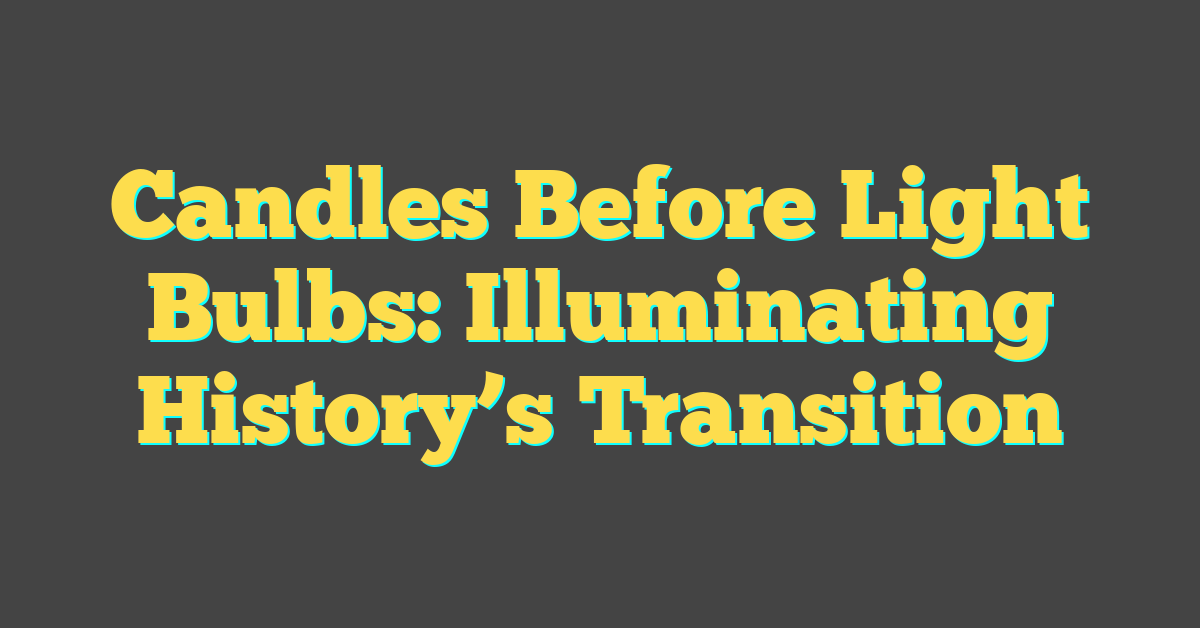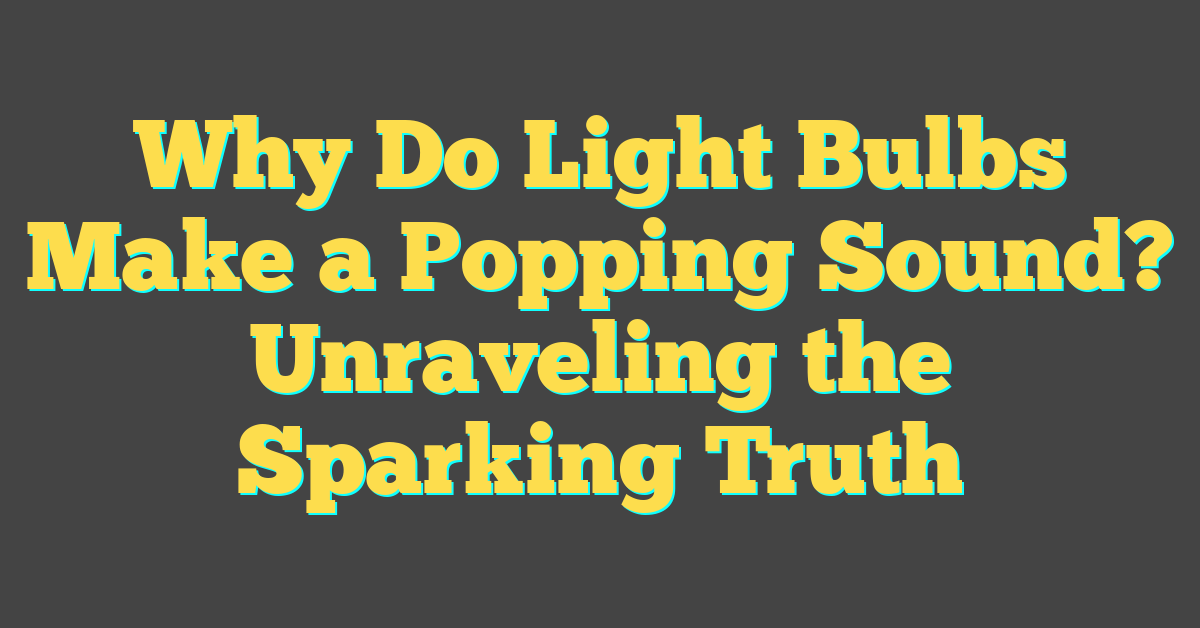Without the invention of light bulbs, our ancestors relied heavily on candles to brighten their nights and illuminate their homes. The existence of candles dates back over thousands of years, originally serving as a primary light source. In earlier times, basic candles were made from tallow and later on beeswax, providing a means to extend day into night. Even as oil lamps came into use, offering a brighter flame and less smoke, candles remained a convenient option because of their portability and simplicity.


The transition from candlelight to the efficiency of electric lamps signalled a profound change in human lifestyle. While gas lighting was a significant advancement, it was the development of light bulbs that marked the dawn of a new era. This invention by Thomas Edison and others like him revolutionized the way people experienced light after darkness fell. Despite the switch to electric lighting, candles have endured, evolving from a lighting necessity to a decorative and ceremonial object used for ambiance, scent, and tradition.
Key Takeaways
- Candles were a primary light source before the electric era.
- The invention of the light bulb vastly changed lighting methods.
- Candles now serve a decorative and ceremonial role.
The Evolution of Artificial Lighting
https://www.youtube.com/watch?v=TGEU1-zRjpA&embed=true
As you explore the history of artificial lighting, you’ll discover how humanity has illuminated the night, progressing from simple flames to the complex electric systems we know today.
From Fire to Candles
You’ve likely marveled at the simple beauty of a candle’s flame. Candles, once a primary source of artificial light, are crafted from materials like tallow or beeswax. They provided a portable solution for lighting needs, evolving over time to become more efficient and cleaner-burning.
Oil Lamps and Gas Lighting
Moving beyond candles, oil lamps were an advancement in lighting technology, utilizing animal fats or plant oils to produce light. These lamps were a staple in many homes until the 19th century, when gas lighting emerged. This method piped coal gas to light public streets and buildings, dramatically improving nighttime visibility in urban areas.
The Invention of Electric Lighting
Then came the era of electric lighting, a revolutionary change from the flame-based light sources of the past. Incandescent bulbs, invented by Thomas Edison, made use of electricity to heat a filament until it glowed, providing consistent and reliable illumination.
By understanding these transformative stages, from flickering fire to the warm glow of candles, the convenience of oil lamps and gas lighting, to the bright efficiency of electric lighting, you gain an appreciation for the ingenuity and progress that has brought us into the well-lit modern age.
The Candle Era
https://www.youtube.com/watch?v=mW8DZPTT13M&embed=true
Before you flick a switch to illuminate your room, imagine a time when candles were the primary source of light after sunset. You’ll find that candles were not just tools for lighting; they represented a significant part of everyday life and the economy.
Materials and Production
To start, you should know that the production of candles was a craft that relied heavily on tallow and beeswax. Tallow, a form of animal fat, was commonly used for candle-making due to its wide availability and low cost. While tallow candles were economical, they produced a less pleasant odor and smoky flame compared to their counterpart, beeswax candles. Beeswax, though more expensive, burned cleanly and was often reserved for the churches and the wealthy.
The wick, a crucial part of the candle, was typically made of braided cotton or flax. The making of candles was an arduous task; tallow had to be rendered and purified, then poured around a wick. For beeswax candles, the process often involved repeatedly dipping the wick into molten wax, slowly building up layers to the desired thickness.
Candles in Society
Your ancestors would have seen candles as indispensable. They not only illuminated homes but also symbolized social status. The bright and steady light of a beeswax candle was a luxury often reserved for the affluent. In contrast, the working class generally used tallow candles, which smoked and smelled but fulfilled the essential task of lighting the darkness.
In the Victorian Age, candles played a central role in both domestic life and public spaces until the advent of gas lighting and later, electric lighting. Activities from dining to reading were all conducted by candlelight. These candles weren’t merely functional; they were interwoven with cultural practices and the rhythms of daily life.
Oil Lamps Through History
« JXLcam Light Bulb Manual: Your Guide to Installation and Features
Good Alternative to Light Bulbs: Eco-Friendly Lighting Solutions »
https://www.youtube.com/watch?v=0OETwH9P4Gs&embed=true
Oil lamps have played an important role in the evolution of human society, providing light after dark for thousands of years. Initially simple vessels filled with burnable oil, they’ve evolved through innovation and necessity.
Ancient Designs
During the Bronze Age, the earliest oil lamps were stones with depressions to hold olive oil, which was ignited to create a flame. By the Iron Age, you would find lamps made from terracotta with wicks to better control the flame and burn more evenly. It’s fascinating to note how these designs reflect the ingenuity of ancient civilizations, aiming for efficiency with the resources at hand.
Improvements in Fuel and Efficiency
Later improvements shifted focus to the fuel used and the lamp’s efficiency. While olive oil was a popular choice in ancient times, other oils, like whale oil, gained usage due to their higher light output and slower burn rate. The design of oil lamps also progressed to contain the oil more securely and manage airflow for a steadier flame, greatly improving the reliability and usefulness of the lamp in your day-to-day life.
The Birth of Electric Lighting

Before the common use of electric light bulbs, your world was mostly illuminated by candles and gas lamps. Let’s take a closer look at the pioneers and advancements that paved the way for the modern electric lighting you now depend on.
Key Innovators
Thomas Edison and Joseph Swan were pivotal figures in the creation of the incandescent light bulb. While Edison is often credited with its invention, Swan independently developed a similar technology in the United Kingdom. What you might find fascinating is that both inventors filed patents for the electric light bulb in the same year, 1879. This eventually led to the merging of their interests and the formation of a joint company.
Technological Breakthroughs
The electric light bulb evolved through several significant technological breakthroughs. The first commercially viable incandescent light was not from Edison or Swan but originated around 1802 from Humphry Davy’s electric arc lamp. However, it was Edison’s and Swan’s improvements that made the light bulb practical for wide-scale use. Their bulbs used a carbon filament, which when electrically heated in a vacuum, glowed to bring forth light without quickly burning out.
The development of the electric light bulb marked a significant transition from dim, flickering candlelight to a steady and controllable electric source. Edison’s version, often noted for its commercial success, utilized a higher resistance filament which allowed for a longer-lasting bulb and a more efficient and safer distribution system. Your everyday life was undeniably transformed by their work, making electric lighting accessible and setting the stage for future innovations.
Light Bulbs and Their Impact
https://www.youtube.com/watch?v=BRH5uoVbRWc&embed=true
With the invention of the incandescent light bulb, your world changed dramatically. No longer were you bound by the limitations of candles and oil lamps; this pioneering advance brought electric light into homes and streets, fueling an era of progress and convenience.
Social and Economic Influence
Your social encounters and economic activities were never the same once light bulbs entered the picture. For example, the introduction of street lighting was a major development in urban areas, improving safety and extending productive hours beyond sunset, thus supporting more vibrant night-time economies. Workplaces also benefited from the adoption of incandescent light, as factories were able to operate with fewer constraints from daylight hours, boosting productivity and contributing to the progress of the Industrial Revolution.
Health and Environment
Your health and the environment also felt the effects of the light bulb’s introduction. On the one hand, electric lights reduced the fire hazards associated with open flames from candles and gas lamps. On the other hand, as light bulbs proliferated, a new phenomenon known as light pollution began to obscure your view of the stars and affected nocturnal wildlife. The incandescent bulb, while a great leap forward from previous lighting methods, was not particularly energy-efficient, leading to increased energy consumption and playing a part in environmental concerns connected with electricity use.
By embracing incandescent light bulbs, your everyday life experienced significant transformations. From altering the rhythm of your social and work life to introducing complex health and environmental discussions, the impact of this technology is profound and far-reaching.
Advancements in Electric Lamps

As you explore the history of electric lamps, you’ll find that major leaps from one technology to another have defined how we light up our lives. Here, you’ll uncover the transitions from incandescent lamps to fluorescent lighting, and ultimately, the mass adoption of LEDs—which stand for light-emitting diodes.
From Incandescent to Fluorescent
The story of the electric lamp began to shine brightly with the invention of the incandescent lamp. Pioneered by figures like Thomas Edison, these lamps used a filament—initially carbon, then later tungsten—that glowed when an electric current passed through it. Despite their warm glow, incandescent lamps were not particularly energy-efficient.
Progress did not stand still, and soon, the fluorescent lamp made its debut. Much more energy-efficient than their incandescent predecessors, fluorescent lamps work by passing electricity through a gas, producing ultraviolet light that then causes a phosphor coating on the inside of the lamp to glow.
The LED Revolution
Your next leap in lighting came with the LED Revolution. LEDs turned previous concepts of bulb longevity and energy efficiency on their head. These semiconductor devices convert electricity directly into light more efficiently than incandescent and fluorescent lamps, and they last much longer. Plus, they are versatile. They fit into everything from the screen you’re reading this on to streetlights that guide your way home.
LED technology continues to evolve, becoming brighter, more color-accurate, and even more energy-efficient. It’s a bright future for lighting, and you’re living right in the midst of this illuminating transformation.
Candle-Making Techniques
https://www.youtube.com/watch?v=vNeAXr0PisM&embed=true
Before diving into the detailed practices of candle-making, it’s important for you to understand that the craft has evolved significantly. From traditional materials like beeswax to the integration of scents and colors, the journey of candle-making techniques is fascinating.
Historical Practices
Historically, candle-making was a necessity for providing light. Beeswax and tallow were the primary substances used to form the body of the candle, with beeswax being a preferred material due to its pleasant smell compared to the foul-smelling tallow.
- Wick Creation: Early wicks were made from twisted strands of flax or cotton, soaked in melted wax to make them more durable and steady-burning.
- Moulding: Candles were typically formed in moulds made of wood or metal, where melted wax was poured and allowed to set with the wick in place.
- Dipping: Another common method was repeatedly dipping the wick into melted wax, building up layers until the desired thickness was achieved.
The options for adding color or scent were limited, so most candles retained the natural hue and fragrance of the beeswax.
Modern Methods
Today, your candle-making techniques are much more diverse, allowing for personalized and creative candle production.
- Materials: In addition to beeswax, you have options like paraffin, soy, and palm waxes, which can be tailored for different candle types.
- Wicks: You now choose from various pre-made wicks, which can include a metal core for rigidity or be made purely of braided cotton for a cleaner burn.
The following table outlines the basic steps in modern candle-making with scent and coloring:
| Step | Description |
|---|---|
| 1. Prepping the Wick | Secure your wick to the bottom of the container, ensuring it’s centered. |
| 2. Melting the Wax | Gently melt your chosen wax in a double boiler, monitoring the temperature. |
| 3. Adding Color and Scent | Once the wax is melted, stir in your desired coloring and scent oils. |
| 4. Pouring Wax | Pour the wax into your container, avoiding the wick displacement. |
| 5. Setting | Allow the candle to cool slowly, trimming the wick to the appropriate length once solidified. |
With these methods, your candles can possess an array of beautiful colors and fragrances to match any mood or décor. Whether you’re continuing the time-honored practice of dipping and moulding or using contemporary techniques, you’re part of the rich history of candle-making.
Candle Use in Cultural Practices
https://www.youtube.com/watch?v=YSt7GLXbKd4&embed=true
Candles have illuminated countless cultural practices, from religious ceremonies to home decor. They bring warmth, aroma, and a hint of the sacred to various traditions around the world.
Religious and Ceremonial
Throughout history, your ancestors likely used candles in religious rituals. For instance, during Hanukkah, a Jewish holiday, candles serve as a physical reminder of the miracle of the oil that lasted eight days. They’re placed in a menorah, and one is lit for each night of the festival cultural significance. In Christian churches, candles are lit during worship services to signify the presence of God and to bring a sense of solemnity to the practices.
Decorative and Aromatic
Not only for ceremonies, but candles also elevate your home’s decor with their soft glow and can infuse a space with aroma. Their use in home decor reflects personal style and sets a mood — a tranquil ambiance for quite reflection or a festive air during celebrations illuminate celebrations. Aromatherapy candles, specifically, harness the power of fragrance to improve mental and physical well-being by engaging your sense of smell.
Inventors and Innovators

As you explore the roots of electric lighting, you’ll be introduced to luminary figures and trailblazing companies whose innovations abolished the era of darkness and lit the path to the future.
Famous Figures in Lighting History
Thomas Edison and Joseph Swan are pivotal to your understanding of the evolution of electric light. Edison, often credited with the invention of the first practical incandescent bulb, conducted exhaustive experiments to create a light bulb that lasted longer and was commercially viable. Meanwhile, across the Atlantic, Swan developed a carbon filament lamp almost simultaneously, leading to a tangled history of innovation and legal battles over the patents for their technology.
- Thomas Edison: Invented the practical incandescent light bulb
- Joseph Swan: Independently invented a carbon filament electric lamp
Companies and Patents
General Electric (GE), a company originating from Edison’s business ventures, quickly became a titan in the burgeoning electrical industry. Patents played a monumental role in the shaping of these companies, with Edison’s Electric Light Company and Swan’s ventures fiercely protecting their inventions, leading to patent litigations that ultimately resulted in cross-licensing agreements, which allowed both innovators to improve upon and profit from the burgeoning technology.
- General Electric: Emerged from Edison’s ventures and dominated the electric industry
- Patent Conflicts: Facilitated agreements that shaped the collaborative future of electric lighting
By recalling these inventors and their legacy, you’re honoring the genius and persistence that led to the world being illuminated as you know it today.
Environmental Aspects of Lighting

When you switch on a light, you’re doing more than just brightening a room. Your choice of lighting can have wide-ranging environmental impacts, from light pollution affecting the night sky and wildlife to the sustainability of the lighting solutions you choose.
Light Pollution and Wildlife
Light pollution is not just about the stars being obscured from view; it can have serious implications for nocturnal wildlife. When artificial lights illuminate the night sky, they disrupt the natural patterns of light and dark. This has a cascade effect, impacting migratory patterns, breeding cycles, and feeding behaviors of many species.
- Birds may become disoriented during migration, leading to collisions with buildings.
- Sea turtles can struggle to find the ocean due to beachfront lighting.
- Insects are often attracted to lights, interrupting pollination and leading to declines in some populations.
To give you an idea of the scale of the issue, consider that turning off unnecessary outdoor lighting could greatly reduce these effects and help conserve wildlife in your area.
Sustainable Lighting Solutions
The drive for energy efficiency has led to the development of lighting solutions that are more sustainable for the environment. LED lights, for instance, consume approximately 75% less energy than traditional incandescent bulbs, and opting for these can reduce your electricity bills and lower carbon emissions.
Here’s a quick look at the benefits of energy-saving bulbs:
- Less energy consumption (lower utility bills)
- Reduced carbon footprint
- Longer lifespan than traditional bulbs
By choosing energy-saving lighting solutions, you also minimize the amount of waste heading to landfills and the need for frequent replacements. Making the switch to LEDs or other energy-efficient lighting options is a straightforward step in living more sustainably. Your individual choices contribute to a larger collective impact on preserving our environment for future generations.
Conclusion

Through the gradual transition from flickering candles to the bright promise of LEDs, you’ve witnessed a remarkable journey in lighting technology.
The Future of Lighting Technology
Imagine a world where the lights you use contribute to a greener planet. That’s the vision behind emerging innovative lighting solutions. As you look ahead, consider the advances in sustainable developments in lighting—LED technology isn’t just about energy efficiency; it’s paving the way for a brighter, more eco-friendly future. The trend is clear: Lighting will continue to evolve and improve, responding not only to functional needs but also to environmental concerns. You’ll see future trends that not only enhance the quality of light but drastically reduce the carbon footprint associated with illumination.




